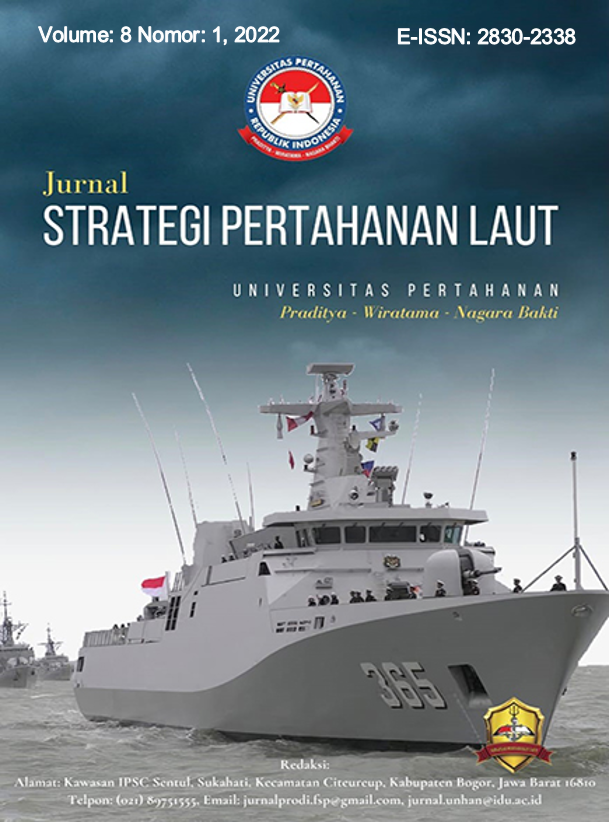NUCLEAR POWERED WARSHIP, DOES INDONESIA NEED IT?
DOI:
https://doi.org/10.33172/spl.v8i1.1039Abstract
The regional security environment is heating up due to the formation of defense cooperation between Australia, America and Britain (AUKUS) with their first agreement, namely the procurement of nuclear-powered attack submarines for Australia from the US. Through the Minister of Foreign Affairs, Indonesia expressed that Indonesia is concerned about the decision because it could disrupt regional security stability and also lead to an arms race. However, this nuclear-powered submarine has many advantages that conventional diesel-powered submarines do not have. Actually, what is a nuclear-powered submarine? Which countries have used it? And does Indonesia also need submarines or other nuclear-powered warships? These three questions will be discussed in research using qualitative methods by considering previous research and international law related to maritime affairs and defense. Although Indonesia needs modernization of defense equipment to be able to balance its power with regional countries, there are many considerations if the modernization is carried out by procuring nuclear-powered submarines, ranging from costs, human resources, facilities, Indonesian principles to applicable international law .References
Burchill, S. (2001). Realism and Neo-realism in Scott Burchill et. al., “Theories of International Relations.” New York: Palgrave.
Carlin, R. (2012). Naval Power & Energy S&T: Hydrogen & Fuel Cells. California: Office of Naval Research.
Dunne, T. &. (2001). Realism in John Baylis and Steve Smith (eds.), “The Globalization of World Politics”. Oxford: Oxford Publishers.
Hananto, A. (2021). Australian Nuclear Warships, and Indonesia's Geopolitical Momentum . Retrieved from Good News From Indonesia: https://www.goodnewsfromindonesia.id/2021/09/21/kapal-perang-nuklir-australia-dan-momentum-indonesia-bergerak
Hiru, M. (2021). The Nuclear Submarine Polemic, Observer: Indonesia Also Needs . Retrieved from Republika.com: https://www.republika.co.id/berita/r0l0g1380/polemic-kapal-selam-nuklir-pengamat-indonesia-juga-perlu
Ministry of Foreign Affairs of the Republic of Indonesia. (2021). Statement on Australian Nuclear Submarines. Retrieved from Kemlu.go.id: https://kemlu.go.id/portal/id/read/2937/siaran_pers/pernyatan-mengenai-kapal-selam-nuklir-australia
Marsetio. (2014). SeaPower Indonesia. Jakarta: Indonesian Defense University.
Ngarayana, IW (2015). NUCLEAR ENERGY BASE AS AN ENERGY HEAD OF THE SORONG Naval Fleet Main Command Headquarters. Proceedings of the 2015 National Seminar on Nuclear Energy Technology .
Sabbath, O. (2021). Nuclear Submarines, Their History and the Countries That Operate . Retrieved from Detik.com: https://www.detik.com/edu/detikpedia/d-5736597/kapal-selam-nuclear-sejarah-dan-negara-yang-operate it
Saputra, EY (2021). Nuclear Submarines, Their History and the Countries That Operate . Retrieved from Tempo.Co: https://dunia.tempo.co/read/1507722/kenapa-kapal-selam-nuklir-jadi-momok-menakukur-bagi-dosa/full&view=ok
Setyawan, BA (2013). Getting to Know Ships with Nuclear Technology. Journal of FT UPNVJ: http://library.upnvj.ac.id/pdf/article/Artikel_jurnal_FT/bt-vol9-no1-jun2013/133-148.pdf.
Staff, F. (2021). Australia to get nuclear submarines: All you need to know about them and why they are important in maritime security. First Post: https://www.firstpost.com/world/australia-to-get-nuclear-submarines-all-you-need-to-know-about-them-and-why-they-are-important-in -maritime-security-9969671.html.
Sugiyono. (2010). Educational Research Methods Quantitative, Qualitative, and R&D Approaches. Bandung: Alphabeta.
Wardhani, B. (2014). Realism, the material is delivered in the International Relations Theory lecture. Surabaya: Department of International Relations, Airlangga University.
Wijaya, P. (2021). Australia Will Have a Nuclear Submarine, What Are the Strengths and Weaknesses? https://www.merdeka.com/dunia/australia-bakal-punya-kapal-selam-nuclear-apa-kelahan-dan-kelemahannya.html.
Zed, M. (2014). Library Research Methods. Jakarta: Indonesia Torch Foundation.
Downloads
Published
How to Cite
Issue
Section
License
Proposed Policy for Journals That Offer Open Access. Authors who publish with this journal agree to the following terms:
- Authors retain copyright and grant the journal right of first publication with the work simultaneously licensed under a Creative Commons Attribution License that allows others to share the work with an acknowledgment of the work's authorship and initial publication in this journal.
- Authors are able to enter into separate, additional contractual arrangements for the non-exclusive distribution of the journal's published version of the work (e.g., post it to an institutional repository or publish it in a book), with an acknowledgment of its initial publication in this journal.
- Authors are permitted and encouraged to post their work online (e.g., in institutional repositories or on their website) prior to and during the submission process, as it can lead to productive exchanges, as well as earlier and greater citation of published work (See The Effect of Open Access).
Proposed Policy for Journals That Offer Delayed Open Access. Authors who publish with this journal agree to the following terms:
- Authors retain copyright and grant the journal right of first publication, with the work [SPECIFY PERIOD OF TIME] after publication simultaneously licensed under a Creative Commons Attribution License that allows others to share the work with an acknowledgment of the work's authorship and initial publication in this journal.
- Authors are able to enter into separate, additional contractual arrangements for the non-exclusive distribution of the journal's published version of the work (e.g., post it to an institutional repository or publish it in a book), with an acknowledgment of its initial publication in this journal.
Authors are permitted and encouraged to post their work online (e.g., in institutional repositories or on their website) prior to and during the submission process, as it can lead to productive exchanges, as well as earlier and greater citation of published work (See The Effect of Open Access)

